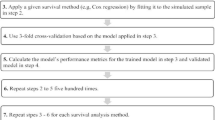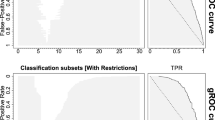Abstract
The problem of selecting between semi-parametric and proportional hazards models is considered. We propose to make this choice based on the expectation of the log-likelihood (ELL) which can be estimated by the likelihood cross-validation (LCV) criterion. The criterion is used to choose an estimator in families of semi-parametric estimators defined by the penalized likelihood. A simulation study shows that the ELL criterion performs nearly as well in this problem as the optimal Kullback–Leibler criterion in term of Kullback–Leibler distance and that LCV performs reasonably well. The approach is applied to a model of age-specific risk of dementia as a function of sex and educational level from the data of a large cohort study.
Similar content being viewed by others
References
Akaike H (1973) Information theory and an extension of the maximum likelihood principle. In: Petrov B, Csaki F (eds) Second International Symposium on Information Theory. Budapest, Akademiai Kiado, pp 267–281
Andersen PK, Borgan R, Gill R, Keiding D (1993) Statistical models based on counting processes. Springer, New York
Commenges D, Letenneur L, Joly P, Alioum A, Dartigues J (1998) Modelling age-specific risk: application to dementia. Statistics in Medicine 17:1973–1988
Commenges D, Joly P, Letenneur L, Dartigues JF (2004) Incidence and prevalence of Alzheimer’s disease or dementia using an Illness-death model. Stat Med 23:199–210
Cox D (1972) Regression models and life tables (with discussion). J R Stat Soc B 34:187–220
Craven P, Wahba G (1979) Smoothing noisy data with spline functions: estimating the correct degree of smoothing by the method of generalized cross-validation. Numer Math 31:377–403
DeLeeuw J (1992) Introduction to Akaike (1973) information theory and an extension of the maximum likelihood principle. In: Kotz S, Johnson NL (eds) Breakthroughs in statistics, vol I. Foundations and basic theory. Springer, New York, pp 599–609
Gray RJ (1994) Splines-based tests in survival analysis. Biometrics 50:640–652
Hastie TJ, Tibshirani RJ (1990) Generalized additive models. Chapman and Hall, London
Ishiguro M, Sakamoto Y, Kitagawa G (1997) Bootstrapping log likelihood and EIC, an extension of AIC. Ann Inst Stat Math 49:411–434
Joly P, Commenges D, Letenneur L (1998) A penalized likelihood approach for arbitrarily censored and truncated data: application to age-specific incidence of dementia. Biometrics 54:185–194
Kooperberg C, Stone CJ, Truong YK (1995) Hazard regression. J Am Stat Assoc 90:78–94
Letenneur L, Commenges D, Dartigues J, Barberger-Gateau P (1994) Incidence of dementia and alzheimer’s disease in elderly community residents of south-western france. Int J Epidemiol 23:1256–1261
Letenneur L, Gilleron V, Commenges D, Helmer C, Orgogozo J, Dartigues J (1999) Are sex and educational level independent predictors of dementia and alzheimer’s disease? Incidence data from the PAQUID project. J Neurol Neurosurg Psychiatry 66:177–183
Liquet B, Commenges D (2004) Estimating the expectation of the log-likelihood with censored data for estimator selection. Lifetime Data Anal 10:351–367
Liquet B, Sakarovitch C, Commenges D (2003) Bootstrap choice of estimators in non-parametric families: an extension of EIC. Biometrics 59:172–178
Miller AJ (1990) Subset selection in regression. Chapman and Hall, New York
O’Sullivan F (1988) Fast computation of fully automated log-density and log-hazard estimators. SIAM J Sci Stat Comput 9:363–379
Ramlau-Hansen H (1983) Smoothing counting process intensities by means of kernel functions. Ann Stat 11:453–466
Schwarz G (1978) Estimating the dimension of a model. Ann Stat 6:461–464
Silverman B (1986) Density estimation for statistics and data analysis. Chapman and Hall, London
Author information
Authors and Affiliations
Corresponding author
Rights and permissions
About this article
Cite this article
Liquet, B., Saracco, J. & Commenges, D. Selection between proportional and stratified hazards models based on expected log-likelihood. Computational Statistics 22, 619–634 (2007). https://doi.org/10.1007/s00180-007-0079-3
Accepted:
Published:
Issue Date:
DOI: https://doi.org/10.1007/s00180-007-0079-3




